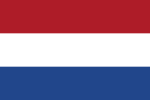Kingdom of Holland
|
Kingdom of Holland Koninkrijk Holland |
|
 Flag of the Kingdom of Holland 1806–1810 |
 Coat of arms of the Kingdom of Holland |
 Kingdom of Holland 1806–1810 |
|
| Official languages | Dutch and French |
| Capital | Amsterdam |
Kingdom of Holland (Dutch Koninkrijk Holland , French: Royaume de Hollande ) was the name of the Netherlands from 1806 to 1810. Before that, the Netherlands, as the Batavian Republic, was a satellite state of the French Republic and Napoleonic France . King of the kingdom was a brother of the French ruler Napoleon , Louis Bonaparte .
The kingdom lasted until 1810 when, within a few months, it was gradually annexed by France . According to his brother, Louis Bonaparte had not sufficiently enforced the interests of France. In 1814/15 the Kingdom of the United Netherlands was founded under the Orange William .
history
The immediate predecessor of the Kingdom of Holland was the Batavian Republic .
On May 24, 1806, a state treaty was concluded between France and the Batavian Republic, also known as the "State of Holland" in the treaty, according to which Prince Louis Bonaparte was appointed and crowned the hereditary and constitutional King of Holland, following a formal request from the representative of the Batavian Republic will. On June 4th, board member Rutger Jan Schimmelpenninck , previously head of state, resigned in Paris . Louis was proclaimed the sovereign King of Holland on June 5, 1806.
The Kingdom of Holland was a state dependent on France . The state name was derived from the most important province, Holland. By the direct takeover of power by a member of the Napoleon family (Napoleonids), the Netherlands should be better controlled.
Louis tried hard to have a good reign and was even popular with the locals. The low resistance of the Dutch can also be explained by the fact that if Louis failed, French intervention was to be expected. But he did not meet Napoleon's expectations; Among other things, it was about the implementation of the continental blockade, the economic blockade against England . In March France began to annex the south first . On July 1, 1810, Louis decided to abdicate to save the kingdom. He left on July 2nd and his decision was published on July 3rd. His still underage son Ludwig II , however, followed him on the throne for only a few days before Napoléon completely annexed the territory of the kingdom to France with the decree of Rambouillet on July 9 . It did not achieve independence until 1813, when it became the Kingdom of the United Netherlands.
Scope and legacy
The Kingdom of Holland roughly encompassed what is now the Netherlands with the exception of Limburg and southern Zeeland , which were French. The kingdom also included East Frisia and the rule of Jever , which were ceded by Prussia and Russia respectively in the Peace of Tilsit in 1807 . After the Napoleonic period, these two areas came back to German princes.
Since Louis moved his government from The Hague to Amsterdam in 1808, Amsterdam is still formally the Dutch capital today. Louis also founded the Koninklijk Instituut van Wetenschappen and laid the foundation for the later Rijksmuseum . He improved the position of Catholics and Jews and in 1809, in addition to a penal code and a commercial code, also introduced a civil code based on the French Civil Code , which was adapted to local characteristics.
Departments
The kingdom was divided into eleven departments:
|
|
See also
Web links
- Koninkrijk Holland (1806–1810) ( Parlement & Politiek ; Dutch)
- Dossier on the Kingdom of Holland from the Royal Library of the Netherlands (Dutch)
Individual evidence
- ↑ Karl Heinrich Ludwig Pölitz : The European Constitutions from 1789 to the Most Recent , Volume 2, Leipzig: Brockhaus, 1833, p. 181 ( Google Books )
- ^ Carl von Rotteck : Staats-Lexikon or Encyklopädie der Staatswissenschaften , Volume 11, Hammerich, 1841, p. 182 ( Google Books )
- ↑ Johann Ernst Fabri : Brief Outline of Geography , 1813, p. 50 ( Google Books )
- ^ Johann Georg Heinrich Hassel : Geographical-statistical outline of the Kingdom of Holland , Weimar: Landes-Industrie-Comptoir, 1809, p. 105 ( Google Books )
